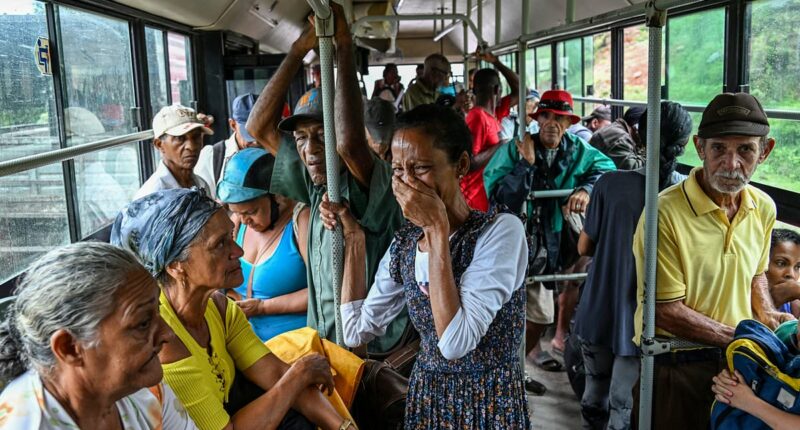Share this @internewscast.com
Hurricane Melissa unleashed its fury on Cuba early Wednesday, following a devastating trail through Jamaica. As a result, 25,000 tourists are stranded, and entire towns find themselves submerged under water.
Dubbed the ‘storm of the century,’ Melissa could leave parts of Jamaica grappling with recovery for days or even weeks. Landslides, along with downed trees and power lines, have hindered rescue teams from reaching some of the most severely flooded areas.
In Cuba, approximately 735,000 people responded to evacuation calls from the nation’s president and emergency services, vacating their homes in coastal and mountainous regions threatened by the storm’s approach on Wednesday.
While Cubans brace themselves against the storm’s wrath, Jamaicans are beginning to assess the extensive damage left in its wake.
Just hours after the formidable Category 5 hurricane first struck Jamaica around 1 p.m. on Tuesday, dramatic footage began to surface.
Images from Black River in St. Elizabeth, one of the hardest-hit areas, reveal the sheer power of the winds that ripped off roofs and flattened entire buildings.
Colorful structures which were left partially standing along Brigade Street in town were submerged in murky floodwaters, hours after Desmond McKenzie, deputy chairman of Jamaica’s Disaster Risk Management Council, warned the entirety of St. Elizabeth was ‘under water.’
Across the island, as many as 530,000 locals are without electricity as emergency crews begin cleanup efforts.

Video from Black River in St. Elizabeth, one of the worst-hit parishes, shows how winds tore the roofs from buildings and leveled others to the ground

As many as 735,000 residents have been evacuated from their homes across Cuba amid fears over the destructive storm

Residents were seen leaving their homes across regions in the path of the storm as they were encouraged to find safe shelter

Residents in Cuba were pictured braving the wild winds ahead of the storm making landfall
AccuWeather Chief Meteorologist Jonathan Porter warned residents or tourists in western Jamaica ‘could be stranded for days or weeks’ as authorities look to begin the monumental cleanup effort.
‘It will be incredibly difficult for emergency aid and resources to reach the hardest hit areas,’ he added.
Jamaican Prime Minister Andrew Holness had echoed concerns about rescue efforts earlier on Tuesday, stating that while efforts could get underway immediately in eastern parts of the island, other ravaged communities may have to wait ‘a few more days.’
‘There is no infrastructure in the region that can withstand a Category 5,’ he said. ‘The question now is the speed of recovery. That’s the challenge.’
At least seven people were dead across the Caribbean before the storm even made landfall, but authorities have not yet been able to provide an accurate updated toll due to the conditions on the ground.
Based on the sheer scale of the devastation, Holness said ‘we are expecting there would be some loss of life.’
But Porter noted ‘the worst impacts from Melissa struck Jamaica during the daylight hours’ – a bleak contrast to the dangers Cuba faces overnight as the island is pummeled in the darkness throughout the early hours of Wednesday.
‘People across Cuba need to be prepared for a dangerous, direct hit from Melissa in the dark,’ he warned.

Men were pictured attempting to protect their cars and belongings ahead of Hurricane Melissa’s arrival in Cuba on Wednesday morning

Devastating images have emerged out of Jamaica as clean up efforts begin
The storm dropped to a Category 3 by early evening on Tuesday but picked up again to become ‘an extremely dangerous’ Category 4 hours before it was due to make landfall in Cuba.
Up to 20 inches (51 centimeters) of rain was forecast across Cuba, along with a significant storm surge along the coast.
In a televised address to the nation Tuesday, Cuban President Miguel Díaz-Canel urged the population to not underestimate the power of the storm, which is ‘the strongest ever to hit national territory.’
‘We want to stress again the need for people to understand the risk it poses because of its scale,’ he said.
Hours later, he revealed more than 735,000 Cubans heeded his warning and evacuated their homes.
‘We have just checked with the provinces the measures in the face of the passage of Melissa,’ he wrote on X. ‘The number of evacuees exceeds 735 thousand, and work continues.’
He warned ‘it will be a very difficult night for all of Cuba’ but vowed the island ‘will recover, always with the faith in victory that Fidel and Raúl instilled in us,’ referring to the Castro brothers, who formerly led Cuba.
Early on Wednesday morning, Jamaica’s Minister of Education, Skills, Youth and Information Dana Morris Dixon, confirmed earlier estimates that 25,000 tourists remained in Jamaica unable to return home as airports closed during the storm.

Horrifying video shows colorful buildings submerged in murky floodwaters, while others were destroyed entirely, in Jamaica

Residents in a Cuban town in the path of the storm were pictured earlier on Tuesday evacuating their homes

Children were evacuated from their homes with the assistance of military personnel in Cuba
Among them are Texas newlyweds Kasydee and Hunter Bishop, who arrived in Montego Bay shortly before evacuation orders were issued.
The airport has since been boarded up and all flights canceled as a result of the mammoth storm.
‘We really have no idea what to expect,’ the couple told Fox 4.
But she assured the wider community ‘there is no need to worry’ and that the government and Ministry of Tourism has been ‘in constant communication with all of the hotels.’
She said authorities are ‘providing support and keeping those tourists as safe as we possibly can.’
Almost every parish in the country is experiencing blocked roads, fallen trees, damaged utility poles and excessive flooding, Disaster Risk Management Council chairman McKenzie said.
He said four main hospitals are damaged, with the storm knocking out power to one of them, forcing officials to evacuate 75 patients.
Floodwaters trapped at least three families in their homes in the community of Black River in western Jamaica, and crews were unable to help them because of dangerous conditions.

Among the 25,000 stranded tourists are Texas newlyweds Kasydee and Hunter Bishop, who arrived in Montego Bay shortly before evacuation orders were issued

Extraordinary images had also emerged from Haiti overnight as schools were converted into makeshift shelters to seek cover from the intense deluge of rain caused by the outer bands of the hurricane as it swept through the Caribbean

Homes have been leveled across Jamaica, and there are concerns about how long it will take to assess and rebuild some of the worst-hit regions
‘Roofs were flying off,’ he said. ‘We are hoping and praying that the situation will ease so that some attempt can be made to get to those persons.’
AccuWeather experts have warned that the preliminary estimate for the total damage and economic loss across Jamaica could reach $22billion.
‘The reports that we have had so far would include damage to hospitals, significant damage to residential property, housing and commercial property as well, and damage to our road infrastructure,’ Jamaica’s Prime Minister Andrew Holness said.
President Donald Trump vowed to offer assistance to Jamaica when cleanup efforts begin and the monumental task of rebuilding begins.
‘On a humanitarian basis, we have to, so we’re watching it closely,’ he said. ‘We’re prepared to move. It’s doing tremendous damages as we speak.’
Trump also marveled at the storm’s strength. It was a Category 5 when it made landfall in Jamaica – the worst the island has ever seen.
‘I’ve never seen that before. I guess it can get that high, but I’ve never seen it,’ he said.
As many as 15,000 people across Jamaica were in shelters on Tuesday as winds topped 185 mph (295 kph).

In Cuba, locals were seen waiting in the streets for food as rain poured down
In Kingston, officials warned people to watch out for crocodiles that might be displaced from their habitats by flooding.
Extraordinary images had also emerged from Haiti overnight as schools were converted into makeshift shelters to seek cover from the intense deluge of rain caused by the outer bands of the hurricane as it swept through the Caribbean.
The pictures showed women and children hunkering down in the shelter and trying to get some sleep as the downpour carried on throughout the night.

















